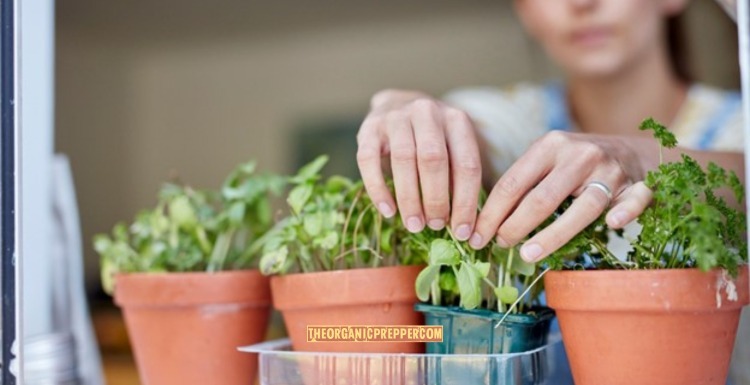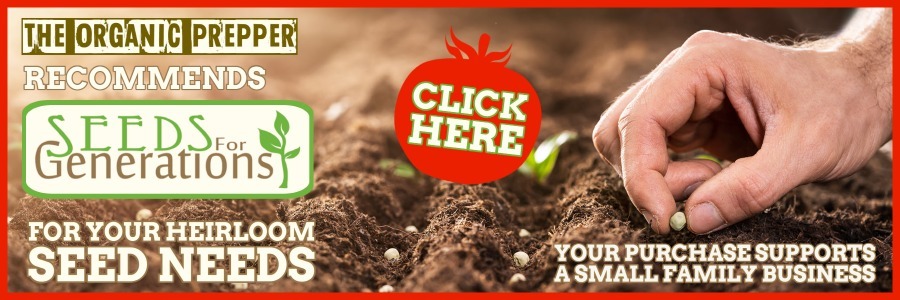If you're new here, you may want to subscribe to my RSS feed. Thanks for visiting!
by Nicole McCray
For some, it may seem challenging or even impossible to grow an indoor garden. Sure, a big garden full of vegetables and herbs is a dream of many people. But, if you don’t have the space, resources, or capabilities, growing indoors is a fantastic option. And, it’s not as challenging as it may seem.
What stops people from growing a garden?
Apartment dwellers often say they don’t have space for a large outdoor garden. People who live in cold climates find it exceptionally challenging to grow an outdoor garden for much of the year. Sometimes physical challenges present, and people can’t manage the amount of labor a large garden requires.
These are all valid reasons. However, there are many reasons to grow food. For preppers, growing food is one way to become a producer and more self-reliant. Maybe you want to grow some fresh greens and herbs in the winter. Or, perhaps you want to contribute to your family’s food supply. Whatever your reasons are for not doing it, growing indoors is the solution.
What plants can I grow in an indoor garden?
Lots of plants can be grown indoors! You’re only limited by the amount of space and time you want to commit. For example, leafy green vegetables like lettuce, kale, and spinach will do great indoors, and they don’t take up much space to grow.
Herbs like rosemary, thyme, parsley, basil, and chives can all be grown year-round on a sunny windowsill. But if you have space and resources to create the right conditions, you can grow things like cucumbers, tomatoes, and even peppers indoors.
When you’re deciding what to grow, think about what your goals are. Growing things your family likes to eat is a great place to start. If you love to cook from scratch, you might enjoy having fresh herbs just a few steps away from the kitchen. Fresh greens pack a lot of nutrition and can make a significant difference if you’re living off of stored food.
Here are the basic requirements you’ll need to grow an indoor garden and to keep your plants happy and healthy.
Light
If you have a bright, south-facing window with enough sunlight, you can probably grow most greens and herbs on the windowsill or a shelf in front of the window. But many vegetables, like cucumbers and tomatoes, will grow best with about 12 hours of light every day.
Most people don’t have enough natural light coming into their homes to keep plants healthy and happy indoors all year round. You’ll probably have to provide supplemental lighting, at least in the shorter days of winter.
For leafy plants like greens and herbs, regular shop lights are all you need. But if you want to grow fruiting plants like tomatoes, you’ll need to invest in proper, full-spectrum grow lights. Position the lights about three inches above your plants and raise them as the plants grow.
Observe your plants carefully. If they seem leggy or they’re turning yellow, they may not be getting enough light. You want your plants to be lush and green with nice thick stems.
Containers
You’re going to need containers to grow an indoor garden. There are many options, depending on your preferences. To save space, you could start your seeds in small trays and then move them to large containers later on. Having several large pots in your growing area to plant your seeds or start plants directly into them is also an option.
If you choose to plant more than one plant in the large containers, be sure the plants have plenty of room to grow. If the plants are too crowded, their roots won’t have enough space, and they won’t be as productive or healthy. Drainage is also vital for container-grown plants. Ensure your pots have plenty of holes in the bottom and place a tray underneath them to protect your floor.
You may want to consider growing your plants vertically on trellises, shelves, or in hanging baskets. Vertical growing and farming are popular in urban areas because they allow you to grow more food in less space. You could even create your own small-scale, vertical hydroponics set up for easy maintenance and maximum production.
Jayne’s article How to Grow Food With Limited Space offers great advice and suggestions on which containers work best.
Temperature and good airflow
Every plant has its requirements for air and soil temperature. You’ll need to do some research to see what the plants you intend to grow prefer. Some seeds are pretty picky about soil temperatures for germination. Once they’re well established, it’s okay if the temperatures swing a bit in either direction. However, you’ll want to try to keep it as close as possible to ideal growing conditions for maximum production.
For some general guidelines, most greens do best at temperatures between 65 and 70 degrees. Peppers and tomatoes like it warmer: upper 70s to mid-80s is ideal. And most herbs are happiest somewhere in the middle.
Good circulation is crucial for preventing disease and growing strong, thick stems. It’s also helpful for pollination on fruiting plants like cucumbers, tomatoes, and peppers. If your growing space has a window, leave it open for several hours each day to allow the breeze to blow through. Or use a fan to create air movement.
Growing medium and fertilizer
Keep in mind when you grow an indoor garden, plants can’t spread their roots in search of nutrients. Plants grown in containers require high-quality potting soil and regular fertilization. You can choose a potting mix that contains slow-release fertilizer or use a once-a-week liquid fertilizer formulated for veggies and herbs.
If you’re growing in a hydroponic system, you can use perlite, vermiculite, coco coir, gravel, or clay pebbles as your growing medium. Then select a hydroponic nutrient for veggies and herbs and add it to your system as directed by the manufacturer.
Final tips for growing an indoor garden
Harvesting from your plants regularly is essential for keeping production levels high. Many greens can be harvested with the cut and come again method for a continuous harvest. Just be careful not to cut more than one-third of the leaves at a time.
Although every variety is different, most greens will eventually bolt and become bitter. To have a continuous supply of leafy greens, you’ll want to start new plants regularly. Other vegetables and herbs will grow much longer before they need to be replaced. Many herbs are perennial, and perennials are long-term investments for a self-sufficient garden.
Are you ready to start your indoor garden?
While growing all your produce indoors might be a bit unrealistic, you can certainly supplement your food with some fresh salad fixings and herbs. It’s a great way to add some extra vitamins, minerals, and variety to your diet. Have you had success in growing an indoor garden? What were your reasons for growing food indoors? If you have any additional tips to share with readers, or any questions, let’s talk about it all in the comments section below.
About Nicole
Nicole is an avid gardener, always working to perfect her homegrown produce. She loves to try out new from-scratch meals on her family and she’s always tweaking old recipes, subbing in healthier ingredients. She’s constantly researching new homesteading trends and she’s hoping to transition toward completely self-sustaining home growing efforts. She contributes to various farming, growing, cooking, and gardening sites in her spare time, sharing her tips and tricks with others looking to perfect their green thumb.


















Great article! I’ve grown greens and tried to grow tomatoes indoors, and I agree with what you’ve said about lighting, heat, etc. One thing you didn’t mention was a heat mat. These are cheap and can be very helpful in colder climates. Those of us who live where the winters go subzero know all to well that when it’s -40 outside, it’s pretty cold indoors as well. Frost sensitive plants such as tomatoes and peppers don’t enjoy that.
I’ve found grow lights to be a must in winter. The light from the winter sun, even in my south-facing porch door, simply wasn’t enough for fruit set. I had nice tomatoes but no fruit. Also, while tomatoes are self-pollinating cucumbers are not, and I’ve never had much success hand pollinating those tiny flowers. There are no insects here in winter to help either.
Growers might consider smaller tomato varieties, ie micro or dwarf tomatoes. They grow in smaller spaces and can produce heavily under good conditions. Tomatoes such as Maglia Rose go well in hanging baskets. I’ve even heard of people growing strawberries hydroponically but have never tried this myself.
PS when fertilizing, keep micronutrients in mind. I found out the hard way that potting soil is fortified only with NPK. Micronutrients matter.
What potting soil do you use? I mostly grow outdoors– my house is really small. I start seeds inside though and the only potting soil I’ve ever been really happy with is Foxfarm’s. I’m curious, do you have any secret indoor potting soil recipes? 🙂
I use Miracle Gro Seed Starting mix. I’d also love to hear what Nicole uses!
I like Miracle Grow potting mix but for things going into the outdoor gardens I often start seeds in coco coir. In fall I like to bring in the healthiest small tomatoes to over winter.
When starting seeds I often use an old water bed heater as a heat mat. I keep metal shelves in my livingroom’s northeast facing windows. I use shop lights hung above or a grow spotlight on the tomatoes. Greens do ok in natural light.
My kitchen is more humid in our dry desert and windows face east. Moth orchids and most herbs do well in natural light there.
We like sprouts for salads and on sandwhiches. I grow those in quart canning jars with a screen cut to fit the jar top. I rinse and drain the water off the seeds several times a day. The jar ring hold the screen in place nicely. All it takes is natural light and cool fresh water.
I buy alfalfa, onion, celery, radish, and mung bean seeds for sprouting. A separate jar for each kind of seeds.